University Project Report: Sustainable Tourism Development Analysis
VerifiedAdded on 2020/01/21
|24
|10752
|79
Report
AI Summary
This report provides a comprehensive analysis of sustainable tourism development, focusing on Chumbe Island as a case study. It begins by identifying key stakeholders and their benefits in tourism planning, followed by an examination of the advantages and disadvantages of public/private sector partnerships. The report then delves into tourism development planning at different levels, evaluating interactive planning systems and methods for measuring tourist impact. Sustainability in tourism is explored, including factors hindering development and planning stages. The report also addresses conflict resolution, balancing supply and demand, and ethical issues in enclave tourism. Finally, it compares current tourism development issues and offers recommendations for future development, concluding with insights into socio-cultural, environmental, and economic aspects relevant to developing countries and emerging destinations.
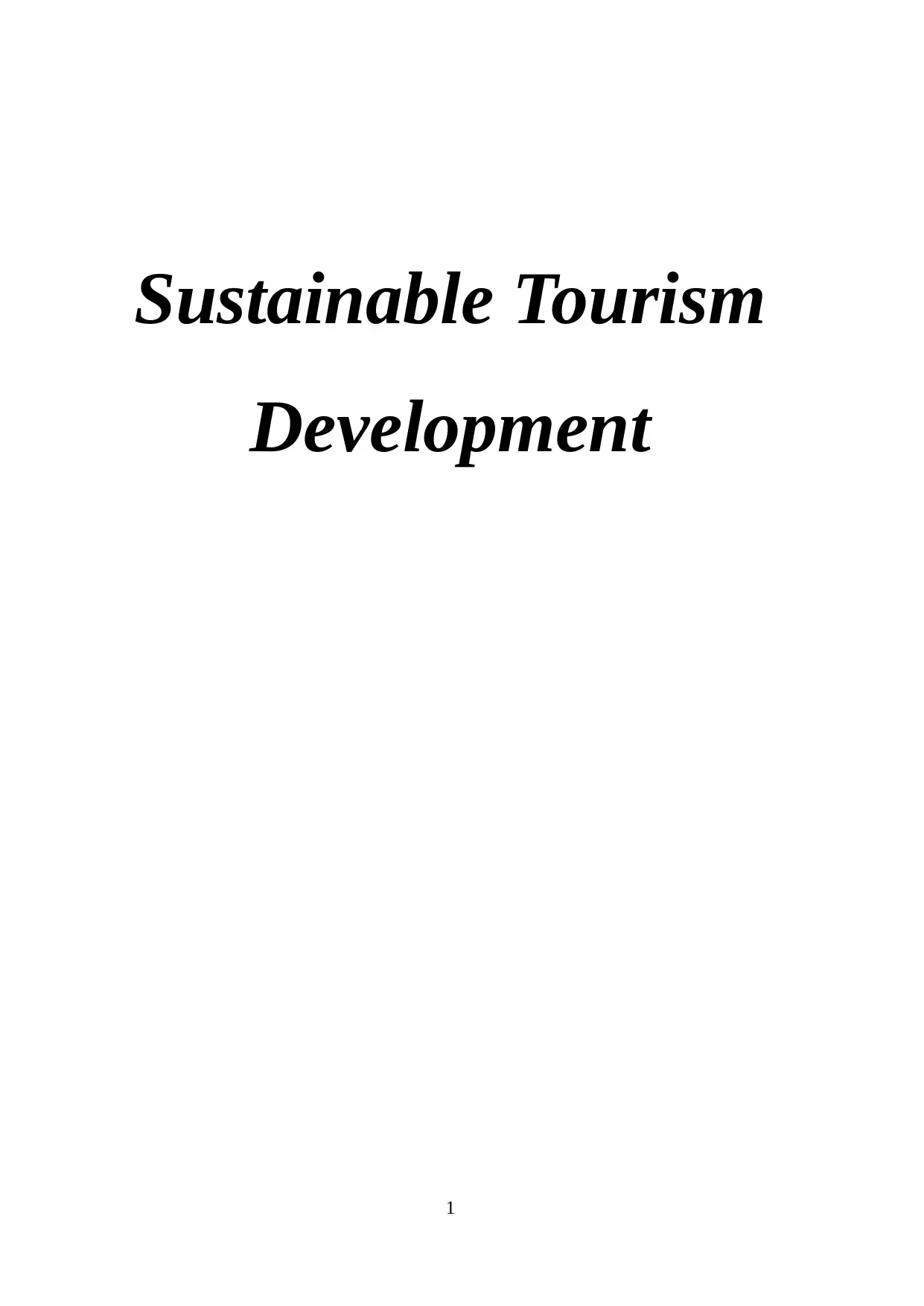
Sustainable Tourism
Development
1
Development
1
Paraphrase This Document
Need a fresh take? Get an instant paraphrase of this document with our AI Paraphraser
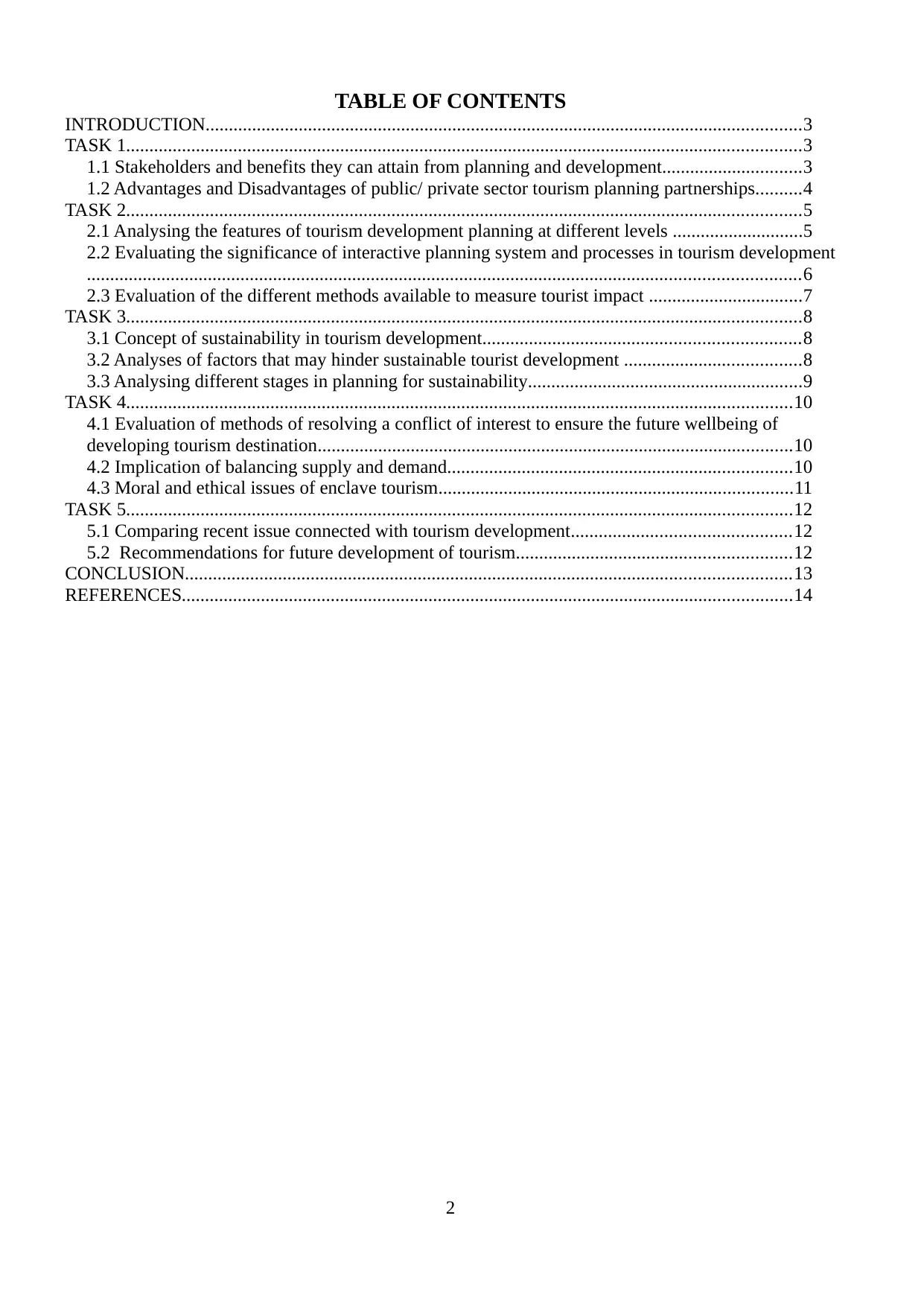
TABLE OF CONTENTS
INTRODUCTION................................................................................................................................3
TASK 1.................................................................................................................................................3
1.1 Stakeholders and benefits they can attain from planning and development..............................3
1.2 Advantages and Disadvantages of public/ private sector tourism planning partnerships..........4
TASK 2.................................................................................................................................................5
2.1 Analysing the features of tourism development planning at different levels ............................5
2.2 Evaluating the significance of interactive planning system and processes in tourism development
.........................................................................................................................................................6
2.3 Evaluation of the different methods available to measure tourist impact .................................7
TASK 3.................................................................................................................................................8
3.1 Concept of sustainability in tourism development....................................................................8
3.2 Analyses of factors that may hinder sustainable tourist development ......................................8
3.3 Analysing different stages in planning for sustainability...........................................................9
TASK 4...............................................................................................................................................10
4.1 Evaluation of methods of resolving a conflict of interest to ensure the future wellbeing of
developing tourism destination......................................................................................................10
4.2 Implication of balancing supply and demand..........................................................................10
4.3 Moral and ethical issues of enclave tourism............................................................................11
TASK 5...............................................................................................................................................12
5.1 Comparing recent issue connected with tourism development...............................................12
5.2 Recommendations for future development of tourism...........................................................12
CONCLUSION..................................................................................................................................13
REFERENCES...................................................................................................................................14
2
INTRODUCTION................................................................................................................................3
TASK 1.................................................................................................................................................3
1.1 Stakeholders and benefits they can attain from planning and development..............................3
1.2 Advantages and Disadvantages of public/ private sector tourism planning partnerships..........4
TASK 2.................................................................................................................................................5
2.1 Analysing the features of tourism development planning at different levels ............................5
2.2 Evaluating the significance of interactive planning system and processes in tourism development
.........................................................................................................................................................6
2.3 Evaluation of the different methods available to measure tourist impact .................................7
TASK 3.................................................................................................................................................8
3.1 Concept of sustainability in tourism development....................................................................8
3.2 Analyses of factors that may hinder sustainable tourist development ......................................8
3.3 Analysing different stages in planning for sustainability...........................................................9
TASK 4...............................................................................................................................................10
4.1 Evaluation of methods of resolving a conflict of interest to ensure the future wellbeing of
developing tourism destination......................................................................................................10
4.2 Implication of balancing supply and demand..........................................................................10
4.3 Moral and ethical issues of enclave tourism............................................................................11
TASK 5...............................................................................................................................................12
5.1 Comparing recent issue connected with tourism development...............................................12
5.2 Recommendations for future development of tourism...........................................................12
CONCLUSION..................................................................................................................................13
REFERENCES...................................................................................................................................14
2
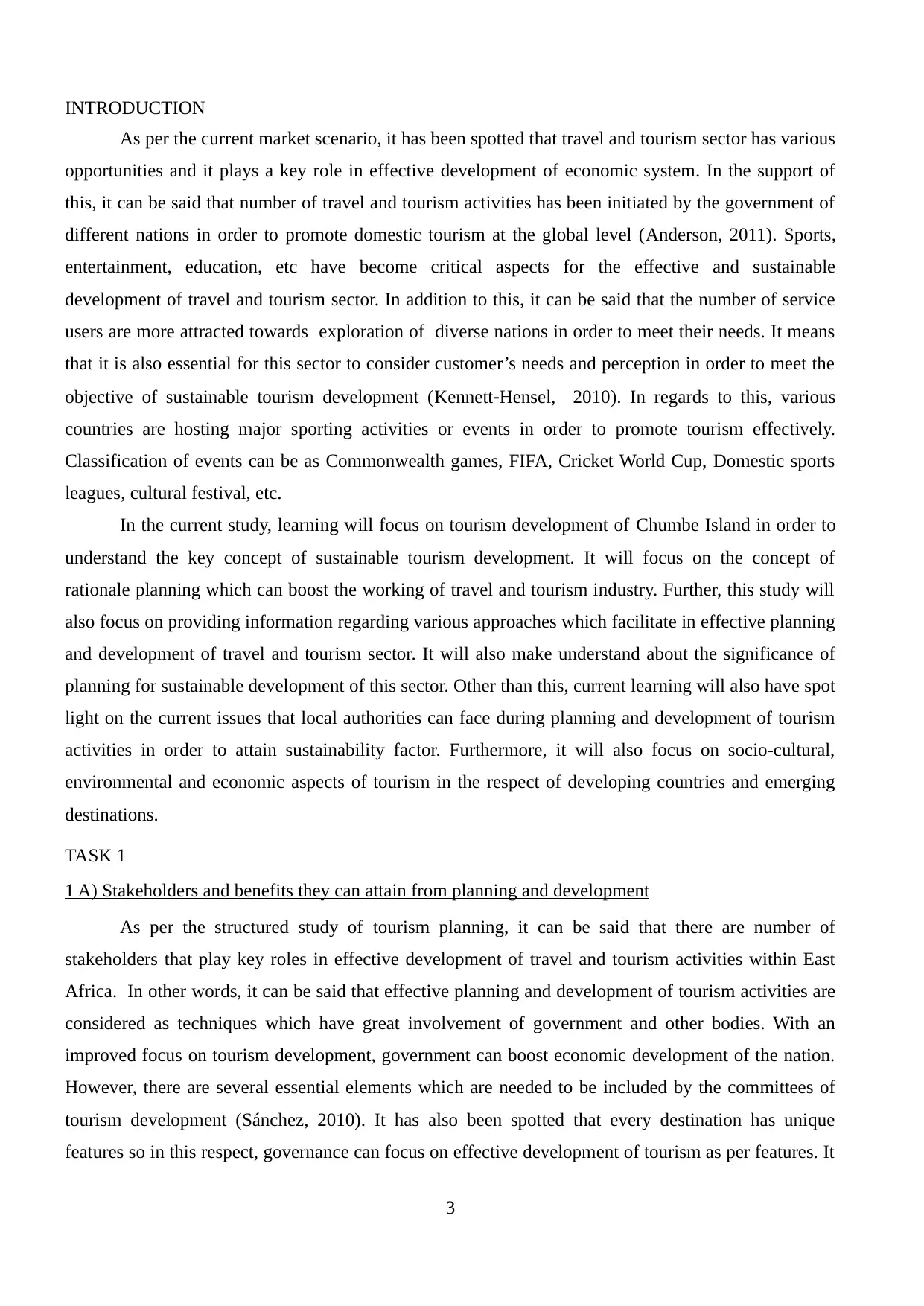
INTRODUCTION
As per the current market scenario, it has been spotted that travel and tourism sector has various
opportunities and it plays a key role in effective development of economic system. In the support of
this, it can be said that number of travel and tourism activities has been initiated by the government of
different nations in order to promote domestic tourism at the global level (Anderson, 2011). Sports,
entertainment, education, etc have become critical aspects for the effective and sustainable
development of travel and tourism sector. In addition to this, it can be said that the number of service
users are more attracted towards exploration of diverse nations in order to meet their needs. It means
that it is also essential for this sector to consider customer’s needs and perception in order to meet the
objective of sustainable tourism development (Kennett‐Hensel, 2010). In regards to this, various
countries are hosting major sporting activities or events in order to promote tourism effectively.
Classification of events can be as Commonwealth games, FIFA, Cricket World Cup, Domestic sports
leagues, cultural festival, etc.
In the current study, learning will focus on tourism development of Chumbe Island in order to
understand the key concept of sustainable tourism development. It will focus on the concept of
rationale planning which can boost the working of travel and tourism industry. Further, this study will
also focus on providing information regarding various approaches which facilitate in effective planning
and development of travel and tourism sector. It will also make understand about the significance of
planning for sustainable development of this sector. Other than this, current learning will also have spot
light on the current issues that local authorities can face during planning and development of tourism
activities in order to attain sustainability factor. Furthermore, it will also focus on socio-cultural,
environmental and economic aspects of tourism in the respect of developing countries and emerging
destinations.
TASK 1
1 A) Stakeholders and benefits they can attain from planning and development
As per the structured study of tourism planning, it can be said that there are number of
stakeholders that play key roles in effective development of travel and tourism activities within East
Africa. In other words, it can be said that effective planning and development of tourism activities are
considered as techniques which have great involvement of government and other bodies. With an
improved focus on tourism development, government can boost economic development of the nation.
However, there are several essential elements which are needed to be included by the committees of
tourism development (Sánchez, 2010). It has also been spotted that every destination has unique
features so in this respect, governance can focus on effective development of tourism as per features. It
3
As per the current market scenario, it has been spotted that travel and tourism sector has various
opportunities and it plays a key role in effective development of economic system. In the support of
this, it can be said that number of travel and tourism activities has been initiated by the government of
different nations in order to promote domestic tourism at the global level (Anderson, 2011). Sports,
entertainment, education, etc have become critical aspects for the effective and sustainable
development of travel and tourism sector. In addition to this, it can be said that the number of service
users are more attracted towards exploration of diverse nations in order to meet their needs. It means
that it is also essential for this sector to consider customer’s needs and perception in order to meet the
objective of sustainable tourism development (Kennett‐Hensel, 2010). In regards to this, various
countries are hosting major sporting activities or events in order to promote tourism effectively.
Classification of events can be as Commonwealth games, FIFA, Cricket World Cup, Domestic sports
leagues, cultural festival, etc.
In the current study, learning will focus on tourism development of Chumbe Island in order to
understand the key concept of sustainable tourism development. It will focus on the concept of
rationale planning which can boost the working of travel and tourism industry. Further, this study will
also focus on providing information regarding various approaches which facilitate in effective planning
and development of travel and tourism sector. It will also make understand about the significance of
planning for sustainable development of this sector. Other than this, current learning will also have spot
light on the current issues that local authorities can face during planning and development of tourism
activities in order to attain sustainability factor. Furthermore, it will also focus on socio-cultural,
environmental and economic aspects of tourism in the respect of developing countries and emerging
destinations.
TASK 1
1 A) Stakeholders and benefits they can attain from planning and development
As per the structured study of tourism planning, it can be said that there are number of
stakeholders that play key roles in effective development of travel and tourism activities within East
Africa. In other words, it can be said that effective planning and development of tourism activities are
considered as techniques which have great involvement of government and other bodies. With an
improved focus on tourism development, government can boost economic development of the nation.
However, there are several essential elements which are needed to be included by the committees of
tourism development (Sánchez, 2010). It has also been spotted that every destination has unique
features so in this respect, governance can focus on effective development of tourism as per features. It
3
⊘ This is a preview!⊘
Do you want full access?
Subscribe today to unlock all pages.

Trusted by 1+ million students worldwide
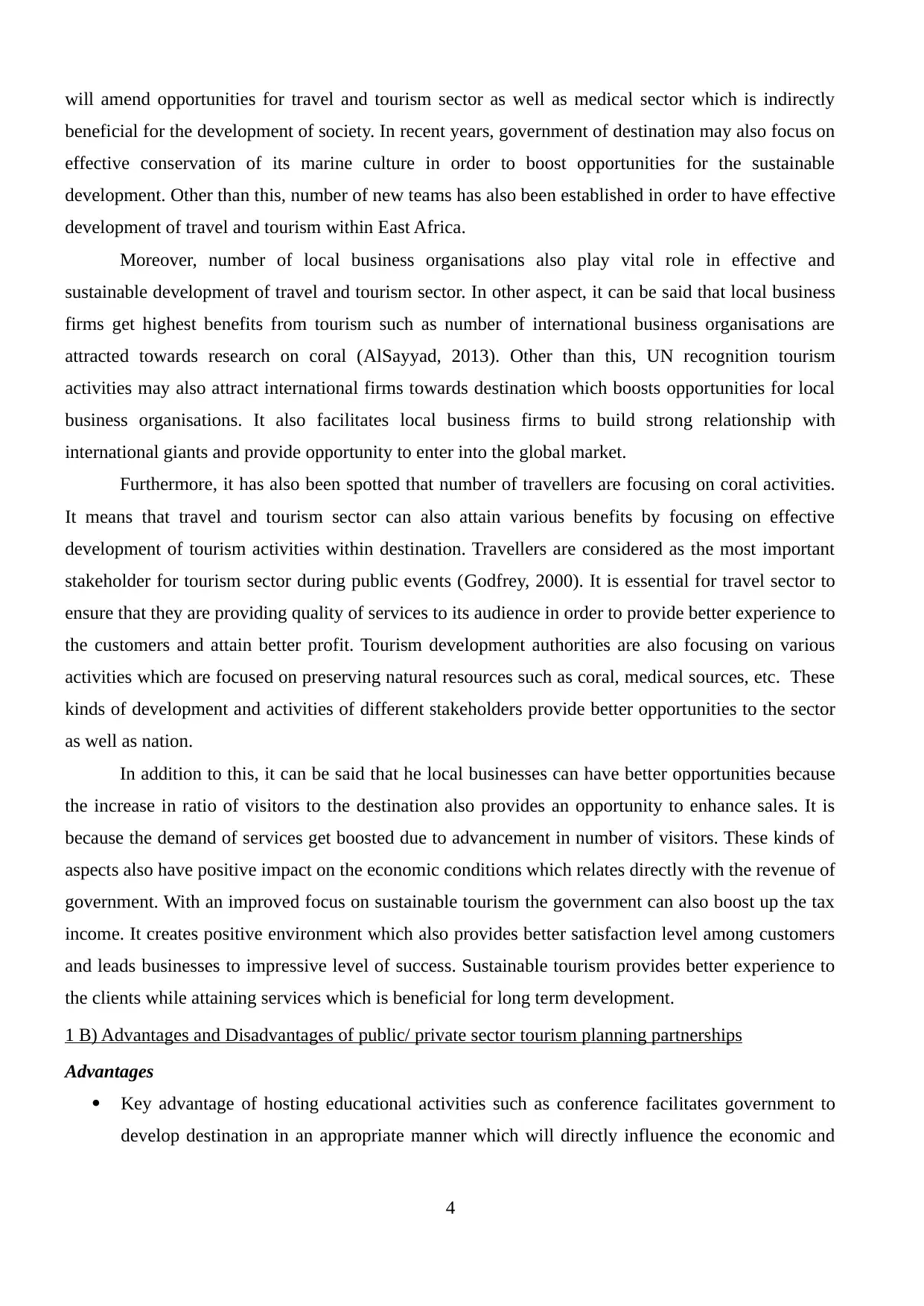
will amend opportunities for travel and tourism sector as well as medical sector which is indirectly
beneficial for the development of society. In recent years, government of destination may also focus on
effective conservation of its marine culture in order to boost opportunities for the sustainable
development. Other than this, number of new teams has also been established in order to have effective
development of travel and tourism within East Africa.
Moreover, number of local business organisations also play vital role in effective and
sustainable development of travel and tourism sector. In other aspect, it can be said that local business
firms get highest benefits from tourism such as number of international business organisations are
attracted towards research on coral (AlSayyad, 2013). Other than this, UN recognition tourism
activities may also attract international firms towards destination which boosts opportunities for local
business organisations. It also facilitates local business firms to build strong relationship with
international giants and provide opportunity to enter into the global market.
Furthermore, it has also been spotted that number of travellers are focusing on coral activities.
It means that travel and tourism sector can also attain various benefits by focusing on effective
development of tourism activities within destination. Travellers are considered as the most important
stakeholder for tourism sector during public events (Godfrey, 2000). It is essential for travel sector to
ensure that they are providing quality of services to its audience in order to provide better experience to
the customers and attain better profit. Tourism development authorities are also focusing on various
activities which are focused on preserving natural resources such as coral, medical sources, etc. These
kinds of development and activities of different stakeholders provide better opportunities to the sector
as well as nation.
In addition to this, it can be said that he local businesses can have better opportunities because
the increase in ratio of visitors to the destination also provides an opportunity to enhance sales. It is
because the demand of services get boosted due to advancement in number of visitors. These kinds of
aspects also have positive impact on the economic conditions which relates directly with the revenue of
government. With an improved focus on sustainable tourism the government can also boost up the tax
income. It creates positive environment which also provides better satisfaction level among customers
and leads businesses to impressive level of success. Sustainable tourism provides better experience to
the clients while attaining services which is beneficial for long term development.
1 B) Advantages and Disadvantages of public/ private sector tourism planning partnerships
Advantages
Key advantage of hosting educational activities such as conference facilitates government to
develop destination in an appropriate manner which will directly influence the economic and
4
beneficial for the development of society. In recent years, government of destination may also focus on
effective conservation of its marine culture in order to boost opportunities for the sustainable
development. Other than this, number of new teams has also been established in order to have effective
development of travel and tourism within East Africa.
Moreover, number of local business organisations also play vital role in effective and
sustainable development of travel and tourism sector. In other aspect, it can be said that local business
firms get highest benefits from tourism such as number of international business organisations are
attracted towards research on coral (AlSayyad, 2013). Other than this, UN recognition tourism
activities may also attract international firms towards destination which boosts opportunities for local
business organisations. It also facilitates local business firms to build strong relationship with
international giants and provide opportunity to enter into the global market.
Furthermore, it has also been spotted that number of travellers are focusing on coral activities.
It means that travel and tourism sector can also attain various benefits by focusing on effective
development of tourism activities within destination. Travellers are considered as the most important
stakeholder for tourism sector during public events (Godfrey, 2000). It is essential for travel sector to
ensure that they are providing quality of services to its audience in order to provide better experience to
the customers and attain better profit. Tourism development authorities are also focusing on various
activities which are focused on preserving natural resources such as coral, medical sources, etc. These
kinds of development and activities of different stakeholders provide better opportunities to the sector
as well as nation.
In addition to this, it can be said that he local businesses can have better opportunities because
the increase in ratio of visitors to the destination also provides an opportunity to enhance sales. It is
because the demand of services get boosted due to advancement in number of visitors. These kinds of
aspects also have positive impact on the economic conditions which relates directly with the revenue of
government. With an improved focus on sustainable tourism the government can also boost up the tax
income. It creates positive environment which also provides better satisfaction level among customers
and leads businesses to impressive level of success. Sustainable tourism provides better experience to
the clients while attaining services which is beneficial for long term development.
1 B) Advantages and Disadvantages of public/ private sector tourism planning partnerships
Advantages
Key advantage of hosting educational activities such as conference facilitates government to
develop destination in an appropriate manner which will directly influence the economic and
4
Paraphrase This Document
Need a fresh take? Get an instant paraphrase of this document with our AI Paraphraser
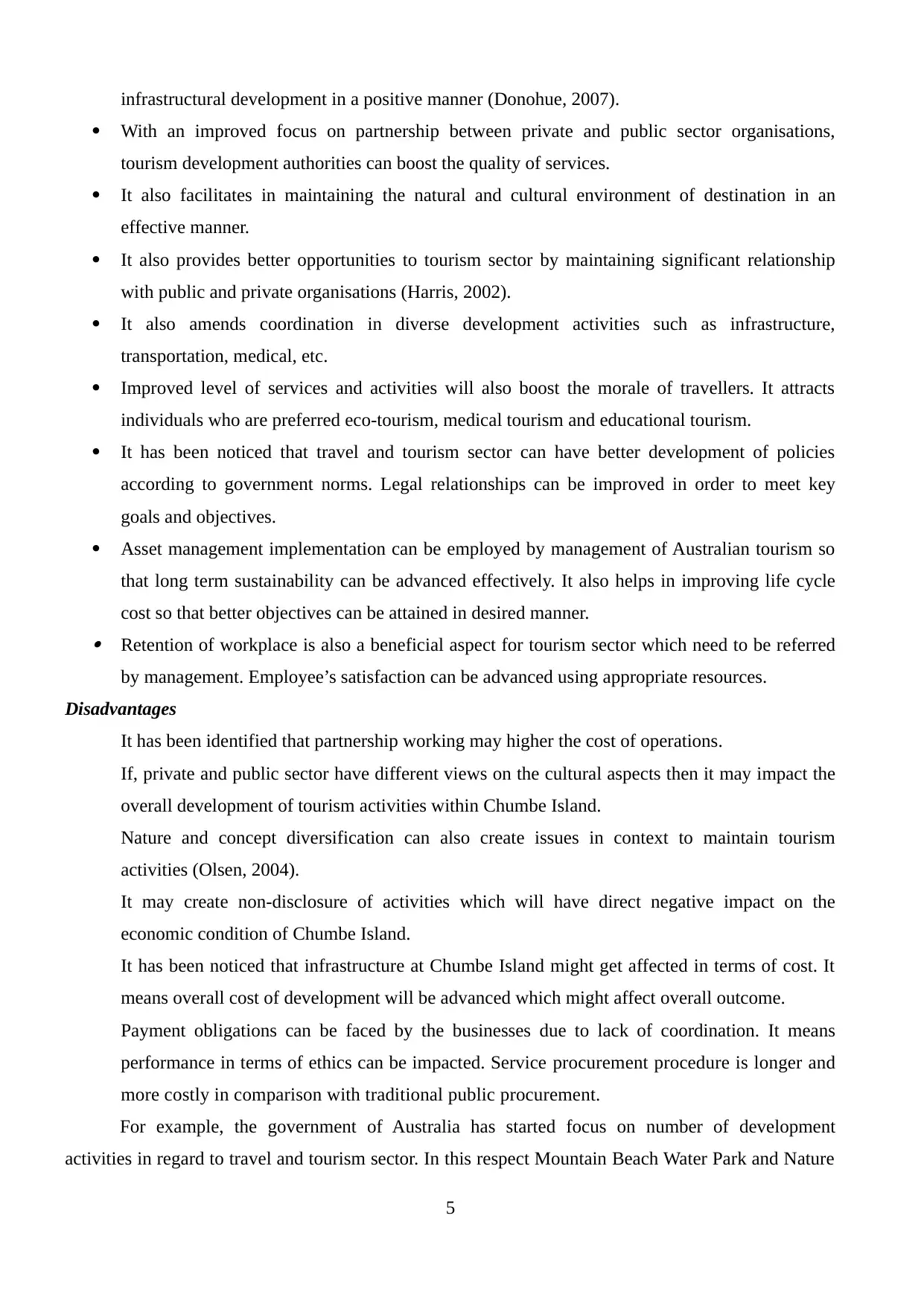
infrastructural development in a positive manner (Donohue, 2007).
With an improved focus on partnership between private and public sector organisations,
tourism development authorities can boost the quality of services.
It also facilitates in maintaining the natural and cultural environment of destination in an
effective manner.
It also provides better opportunities to tourism sector by maintaining significant relationship
with public and private organisations (Harris, 2002).
It also amends coordination in diverse development activities such as infrastructure,
transportation, medical, etc.
Improved level of services and activities will also boost the morale of travellers. It attracts
individuals who are preferred eco-tourism, medical tourism and educational tourism.
It has been noticed that travel and tourism sector can have better development of policies
according to government norms. Legal relationships can be improved in order to meet key
goals and objectives.
Asset management implementation can be employed by management of Australian tourism so
that long term sustainability can be advanced effectively. It also helps in improving life cycle
cost so that better objectives can be attained in desired manner. Retention of workplace is also a beneficial aspect for tourism sector which need to be referred
by management. Employee’s satisfaction can be advanced using appropriate resources.
Disadvantages
It has been identified that partnership working may higher the cost of operations.
If, private and public sector have different views on the cultural aspects then it may impact the
overall development of tourism activities within Chumbe Island.
Nature and concept diversification can also create issues in context to maintain tourism
activities (Olsen, 2004).
It may create non-disclosure of activities which will have direct negative impact on the
economic condition of Chumbe Island.
It has been noticed that infrastructure at Chumbe Island might get affected in terms of cost. It
means overall cost of development will be advanced which might affect overall outcome.
Payment obligations can be faced by the businesses due to lack of coordination. It means
performance in terms of ethics can be impacted. Service procurement procedure is longer and
more costly in comparison with traditional public procurement.
For example, the government of Australia has started focus on number of development
activities in regard to travel and tourism sector. In this respect Mountain Beach Water Park and Nature
5
With an improved focus on partnership between private and public sector organisations,
tourism development authorities can boost the quality of services.
It also facilitates in maintaining the natural and cultural environment of destination in an
effective manner.
It also provides better opportunities to tourism sector by maintaining significant relationship
with public and private organisations (Harris, 2002).
It also amends coordination in diverse development activities such as infrastructure,
transportation, medical, etc.
Improved level of services and activities will also boost the morale of travellers. It attracts
individuals who are preferred eco-tourism, medical tourism and educational tourism.
It has been noticed that travel and tourism sector can have better development of policies
according to government norms. Legal relationships can be improved in order to meet key
goals and objectives.
Asset management implementation can be employed by management of Australian tourism so
that long term sustainability can be advanced effectively. It also helps in improving life cycle
cost so that better objectives can be attained in desired manner. Retention of workplace is also a beneficial aspect for tourism sector which need to be referred
by management. Employee’s satisfaction can be advanced using appropriate resources.
Disadvantages
It has been identified that partnership working may higher the cost of operations.
If, private and public sector have different views on the cultural aspects then it may impact the
overall development of tourism activities within Chumbe Island.
Nature and concept diversification can also create issues in context to maintain tourism
activities (Olsen, 2004).
It may create non-disclosure of activities which will have direct negative impact on the
economic condition of Chumbe Island.
It has been noticed that infrastructure at Chumbe Island might get affected in terms of cost. It
means overall cost of development will be advanced which might affect overall outcome.
Payment obligations can be faced by the businesses due to lack of coordination. It means
performance in terms of ethics can be impacted. Service procurement procedure is longer and
more costly in comparison with traditional public procurement.
For example, the government of Australia has started focus on number of development
activities in regard to travel and tourism sector. In this respect Mountain Beach Water Park and Nature
5
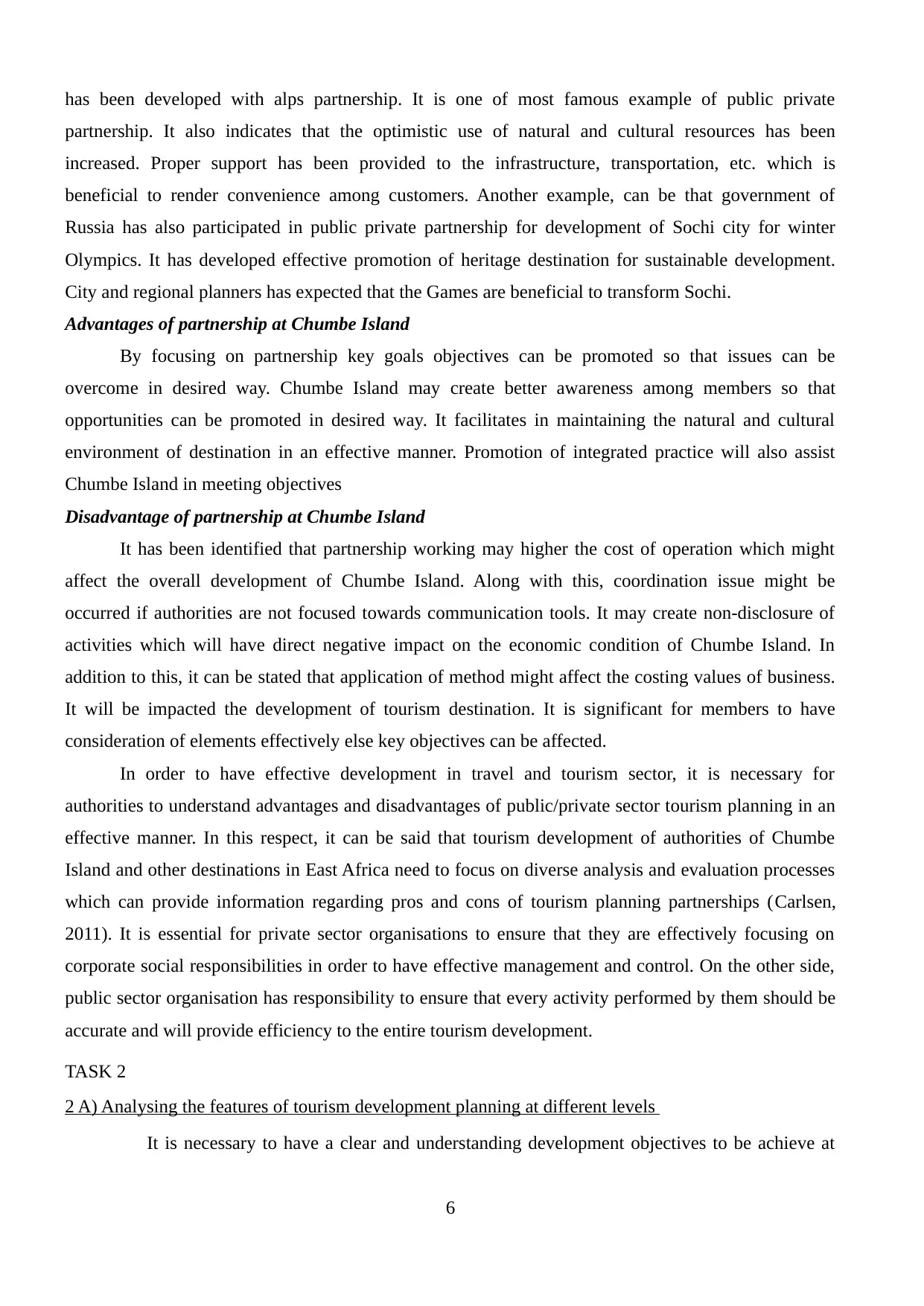
has been developed with alps partnership. It is one of most famous example of public private
partnership. It also indicates that the optimistic use of natural and cultural resources has been
increased. Proper support has been provided to the infrastructure, transportation, etc. which is
beneficial to render convenience among customers. Another example, can be that government of
Russia has also participated in public private partnership for development of Sochi city for winter
Olympics. It has developed effective promotion of heritage destination for sustainable development.
City and regional planners has expected that the Games are beneficial to transform Sochi.
Advantages of partnership at Chumbe Island
By focusing on partnership key goals objectives can be promoted so that issues can be
overcome in desired way. Chumbe Island may create better awareness among members so that
opportunities can be promoted in desired way. It facilitates in maintaining the natural and cultural
environment of destination in an effective manner. Promotion of integrated practice will also assist
Chumbe Island in meeting objectives
Disadvantage of partnership at Chumbe Island
It has been identified that partnership working may higher the cost of operation which might
affect the overall development of Chumbe Island. Along with this, coordination issue might be
occurred if authorities are not focused towards communication tools. It may create non-disclosure of
activities which will have direct negative impact on the economic condition of Chumbe Island. In
addition to this, it can be stated that application of method might affect the costing values of business.
It will be impacted the development of tourism destination. It is significant for members to have
consideration of elements effectively else key objectives can be affected.
In order to have effective development in travel and tourism sector, it is necessary for
authorities to understand advantages and disadvantages of public/private sector tourism planning in an
effective manner. In this respect, it can be said that tourism development of authorities of Chumbe
Island and other destinations in East Africa need to focus on diverse analysis and evaluation processes
which can provide information regarding pros and cons of tourism planning partnerships (Carlsen,
2011). It is essential for private sector organisations to ensure that they are effectively focusing on
corporate social responsibilities in order to have effective management and control. On the other side,
public sector organisation has responsibility to ensure that every activity performed by them should be
accurate and will provide efficiency to the entire tourism development.
TASK 2
2 A) Analysing the features of tourism development planning at different levels
It is necessary to have a clear and understanding development objectives to be achieve at
6
partnership. It also indicates that the optimistic use of natural and cultural resources has been
increased. Proper support has been provided to the infrastructure, transportation, etc. which is
beneficial to render convenience among customers. Another example, can be that government of
Russia has also participated in public private partnership for development of Sochi city for winter
Olympics. It has developed effective promotion of heritage destination for sustainable development.
City and regional planners has expected that the Games are beneficial to transform Sochi.
Advantages of partnership at Chumbe Island
By focusing on partnership key goals objectives can be promoted so that issues can be
overcome in desired way. Chumbe Island may create better awareness among members so that
opportunities can be promoted in desired way. It facilitates in maintaining the natural and cultural
environment of destination in an effective manner. Promotion of integrated practice will also assist
Chumbe Island in meeting objectives
Disadvantage of partnership at Chumbe Island
It has been identified that partnership working may higher the cost of operation which might
affect the overall development of Chumbe Island. Along with this, coordination issue might be
occurred if authorities are not focused towards communication tools. It may create non-disclosure of
activities which will have direct negative impact on the economic condition of Chumbe Island. In
addition to this, it can be stated that application of method might affect the costing values of business.
It will be impacted the development of tourism destination. It is significant for members to have
consideration of elements effectively else key objectives can be affected.
In order to have effective development in travel and tourism sector, it is necessary for
authorities to understand advantages and disadvantages of public/private sector tourism planning in an
effective manner. In this respect, it can be said that tourism development of authorities of Chumbe
Island and other destinations in East Africa need to focus on diverse analysis and evaluation processes
which can provide information regarding pros and cons of tourism planning partnerships (Carlsen,
2011). It is essential for private sector organisations to ensure that they are effectively focusing on
corporate social responsibilities in order to have effective management and control. On the other side,
public sector organisation has responsibility to ensure that every activity performed by them should be
accurate and will provide efficiency to the entire tourism development.
TASK 2
2 A) Analysing the features of tourism development planning at different levels
It is necessary to have a clear and understanding development objectives to be achieve at
6
⊘ This is a preview!⊘
Do you want full access?
Subscribe today to unlock all pages.

Trusted by 1+ million students worldwide
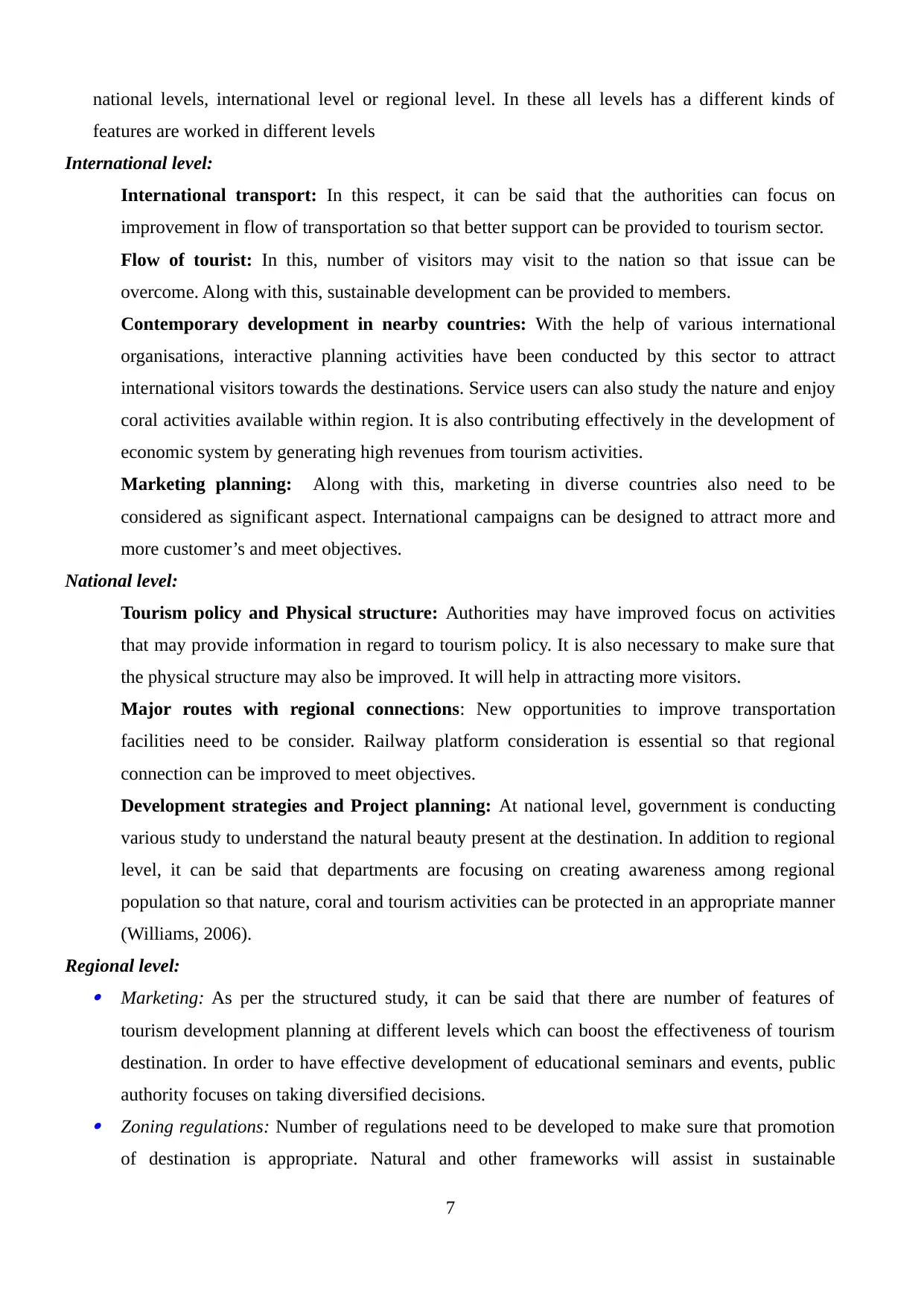
national levels, international level or regional level. In these all levels has a different kinds of
features are worked in different levels
International level:
International transport: In this respect, it can be said that the authorities can focus on
improvement in flow of transportation so that better support can be provided to tourism sector.
Flow of tourist: In this, number of visitors may visit to the nation so that issue can be
overcome. Along with this, sustainable development can be provided to members.
Contemporary development in nearby countries: With the help of various international
organisations, interactive planning activities have been conducted by this sector to attract
international visitors towards the destinations. Service users can also study the nature and enjoy
coral activities available within region. It is also contributing effectively in the development of
economic system by generating high revenues from tourism activities.
Marketing planning: Along with this, marketing in diverse countries also need to be
considered as significant aspect. International campaigns can be designed to attract more and
more customer’s and meet objectives.
National level:
Tourism policy and Physical structure: Authorities may have improved focus on activities
that may provide information in regard to tourism policy. It is also necessary to make sure that
the physical structure may also be improved. It will help in attracting more visitors.
Major routes with regional connections: New opportunities to improve transportation
facilities need to be consider. Railway platform consideration is essential so that regional
connection can be improved to meet objectives.
Development strategies and Project planning: At national level, government is conducting
various study to understand the natural beauty present at the destination. In addition to regional
level, it can be said that departments are focusing on creating awareness among regional
population so that nature, coral and tourism activities can be protected in an appropriate manner
(Williams, 2006).
Regional level: Marketing: As per the structured study, it can be said that there are number of features of
tourism development planning at different levels which can boost the effectiveness of tourism
destination. In order to have effective development of educational seminars and events, public
authority focuses on taking diversified decisions. Zoning regulations: Number of regulations need to be developed to make sure that promotion
of destination is appropriate. Natural and other frameworks will assist in sustainable
7
features are worked in different levels
International level:
International transport: In this respect, it can be said that the authorities can focus on
improvement in flow of transportation so that better support can be provided to tourism sector.
Flow of tourist: In this, number of visitors may visit to the nation so that issue can be
overcome. Along with this, sustainable development can be provided to members.
Contemporary development in nearby countries: With the help of various international
organisations, interactive planning activities have been conducted by this sector to attract
international visitors towards the destinations. Service users can also study the nature and enjoy
coral activities available within region. It is also contributing effectively in the development of
economic system by generating high revenues from tourism activities.
Marketing planning: Along with this, marketing in diverse countries also need to be
considered as significant aspect. International campaigns can be designed to attract more and
more customer’s and meet objectives.
National level:
Tourism policy and Physical structure: Authorities may have improved focus on activities
that may provide information in regard to tourism policy. It is also necessary to make sure that
the physical structure may also be improved. It will help in attracting more visitors.
Major routes with regional connections: New opportunities to improve transportation
facilities need to be consider. Railway platform consideration is essential so that regional
connection can be improved to meet objectives.
Development strategies and Project planning: At national level, government is conducting
various study to understand the natural beauty present at the destination. In addition to regional
level, it can be said that departments are focusing on creating awareness among regional
population so that nature, coral and tourism activities can be protected in an appropriate manner
(Williams, 2006).
Regional level: Marketing: As per the structured study, it can be said that there are number of features of
tourism development planning at different levels which can boost the effectiveness of tourism
destination. In order to have effective development of educational seminars and events, public
authority focuses on taking diversified decisions. Zoning regulations: Number of regulations need to be developed to make sure that promotion
of destination is appropriate. Natural and other frameworks will assist in sustainable
7
Paraphrase This Document
Need a fresh take? Get an instant paraphrase of this document with our AI Paraphraser
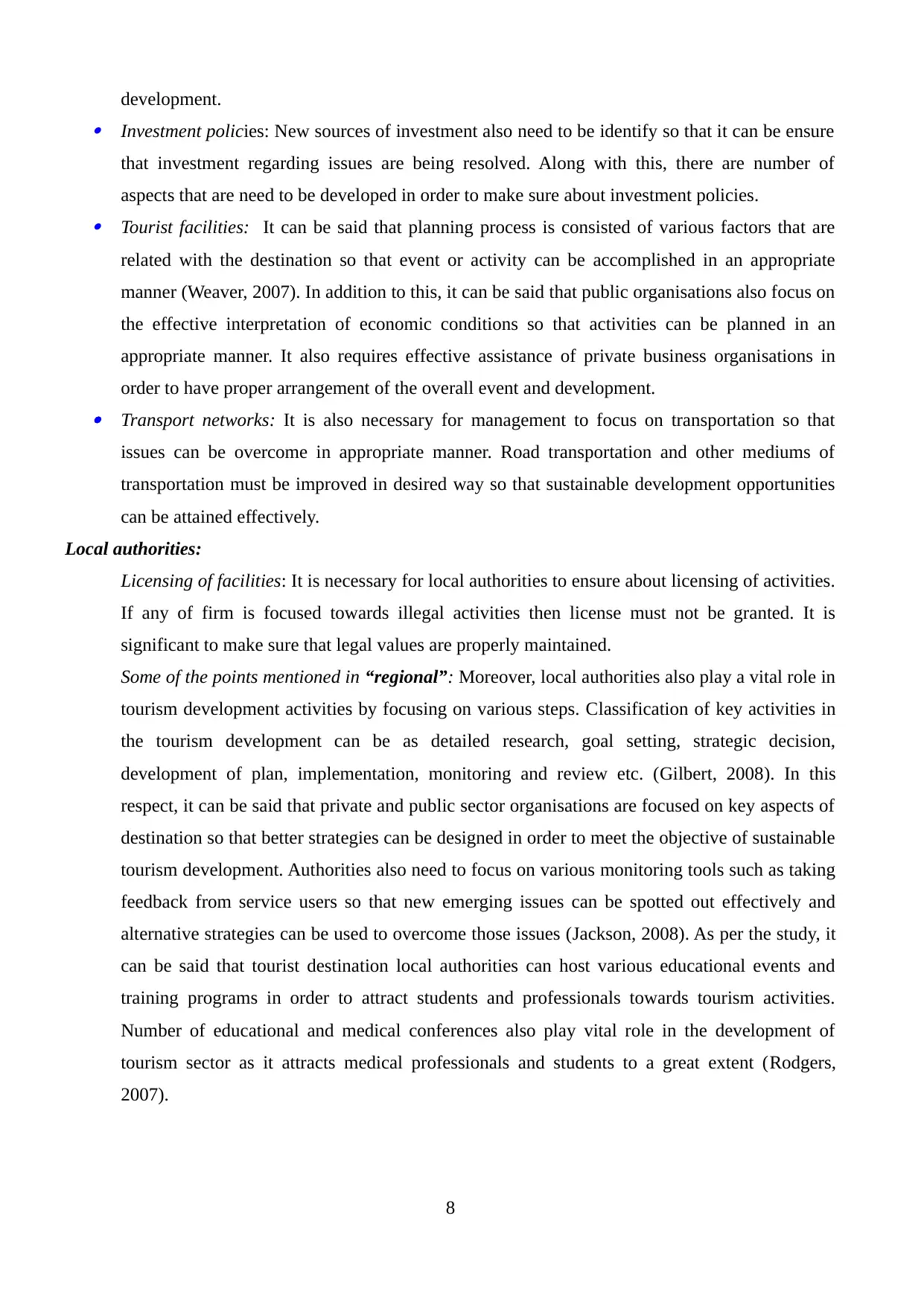
development. Investment policies: New sources of investment also need to be identify so that it can be ensure
that investment regarding issues are being resolved. Along with this, there are number of
aspects that are need to be developed in order to make sure about investment policies. Tourist facilities: It can be said that planning process is consisted of various factors that are
related with the destination so that event or activity can be accomplished in an appropriate
manner (Weaver, 2007). In addition to this, it can be said that public organisations also focus on
the effective interpretation of economic conditions so that activities can be planned in an
appropriate manner. It also requires effective assistance of private business organisations in
order to have proper arrangement of the overall event and development. Transport networks: It is also necessary for management to focus on transportation so that
issues can be overcome in appropriate manner. Road transportation and other mediums of
transportation must be improved in desired way so that sustainable development opportunities
can be attained effectively.
Local authorities:
Licensing of facilities: It is necessary for local authorities to ensure about licensing of activities.
If any of firm is focused towards illegal activities then license must not be granted. It is
significant to make sure that legal values are properly maintained.
Some of the points mentioned in “regional”: Moreover, local authorities also play a vital role in
tourism development activities by focusing on various steps. Classification of key activities in
the tourism development can be as detailed research, goal setting, strategic decision,
development of plan, implementation, monitoring and review etc. (Gilbert, 2008). In this
respect, it can be said that private and public sector organisations are focused on key aspects of
destination so that better strategies can be designed in order to meet the objective of sustainable
tourism development. Authorities also need to focus on various monitoring tools such as taking
feedback from service users so that new emerging issues can be spotted out effectively and
alternative strategies can be used to overcome those issues (Jackson, 2008). As per the study, it
can be said that tourist destination local authorities can host various educational events and
training programs in order to attract students and professionals towards tourism activities.
Number of educational and medical conferences also play vital role in the development of
tourism sector as it attracts medical professionals and students to a great extent (Rodgers,
2007).
8
that investment regarding issues are being resolved. Along with this, there are number of
aspects that are need to be developed in order to make sure about investment policies. Tourist facilities: It can be said that planning process is consisted of various factors that are
related with the destination so that event or activity can be accomplished in an appropriate
manner (Weaver, 2007). In addition to this, it can be said that public organisations also focus on
the effective interpretation of economic conditions so that activities can be planned in an
appropriate manner. It also requires effective assistance of private business organisations in
order to have proper arrangement of the overall event and development. Transport networks: It is also necessary for management to focus on transportation so that
issues can be overcome in appropriate manner. Road transportation and other mediums of
transportation must be improved in desired way so that sustainable development opportunities
can be attained effectively.
Local authorities:
Licensing of facilities: It is necessary for local authorities to ensure about licensing of activities.
If any of firm is focused towards illegal activities then license must not be granted. It is
significant to make sure that legal values are properly maintained.
Some of the points mentioned in “regional”: Moreover, local authorities also play a vital role in
tourism development activities by focusing on various steps. Classification of key activities in
the tourism development can be as detailed research, goal setting, strategic decision,
development of plan, implementation, monitoring and review etc. (Gilbert, 2008). In this
respect, it can be said that private and public sector organisations are focused on key aspects of
destination so that better strategies can be designed in order to meet the objective of sustainable
tourism development. Authorities also need to focus on various monitoring tools such as taking
feedback from service users so that new emerging issues can be spotted out effectively and
alternative strategies can be used to overcome those issues (Jackson, 2008). As per the study, it
can be said that tourist destination local authorities can host various educational events and
training programs in order to attract students and professionals towards tourism activities.
Number of educational and medical conferences also play vital role in the development of
tourism sector as it attracts medical professionals and students to a great extent (Rodgers,
2007).
8
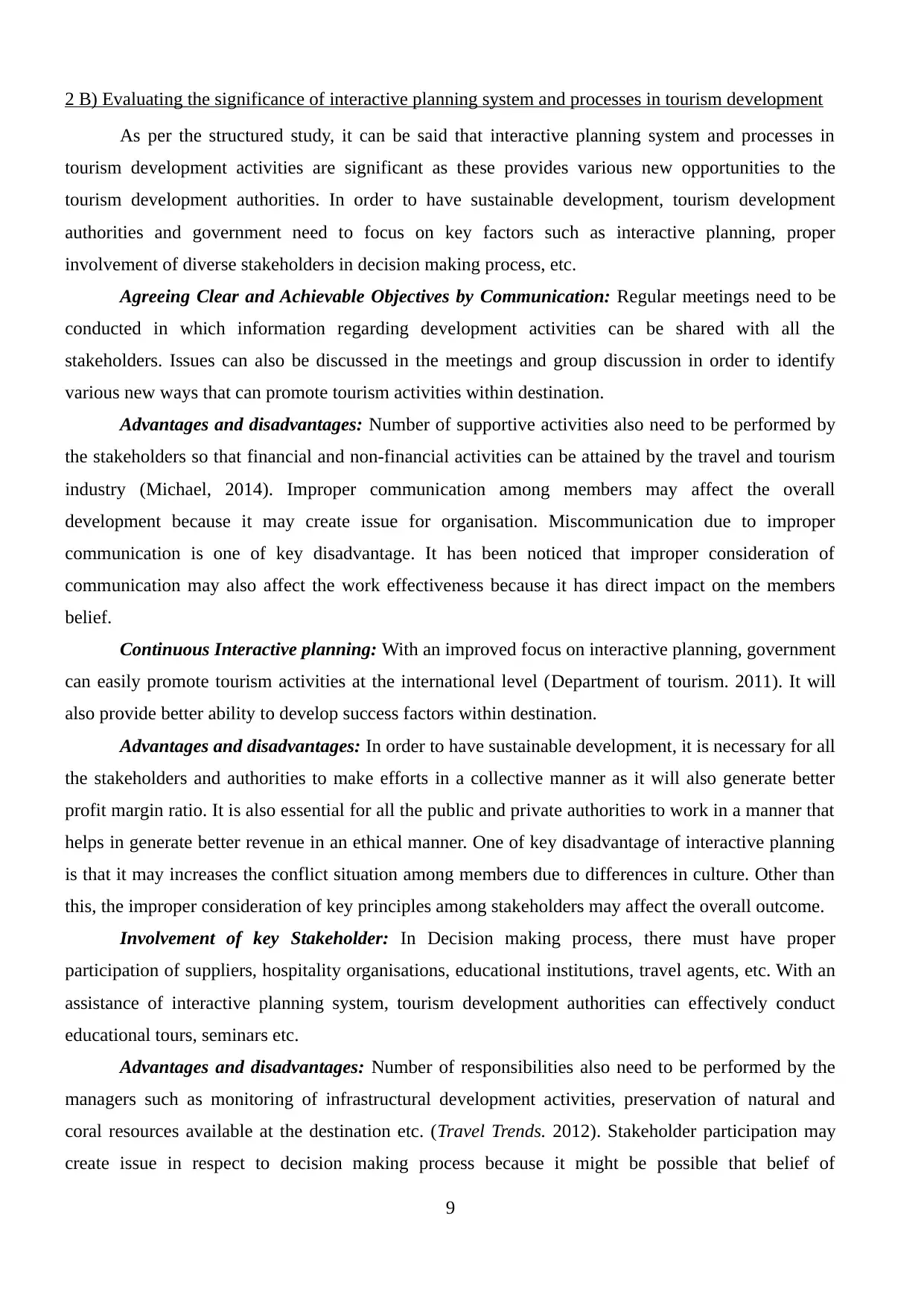
2 B) Evaluating the significance of interactive planning system and processes in tourism development
As per the structured study, it can be said that interactive planning system and processes in
tourism development activities are significant as these provides various new opportunities to the
tourism development authorities. In order to have sustainable development, tourism development
authorities and government need to focus on key factors such as interactive planning, proper
involvement of diverse stakeholders in decision making process, etc.
Agreeing Clear and Achievable Objectives by Communication: Regular meetings need to be
conducted in which information regarding development activities can be shared with all the
stakeholders. Issues can also be discussed in the meetings and group discussion in order to identify
various new ways that can promote tourism activities within destination.
Advantages and disadvantages: Number of supportive activities also need to be performed by
the stakeholders so that financial and non-financial activities can be attained by the travel and tourism
industry (Michael, 2014). Improper communication among members may affect the overall
development because it may create issue for organisation. Miscommunication due to improper
communication is one of key disadvantage. It has been noticed that improper consideration of
communication may also affect the work effectiveness because it has direct impact on the members
belief.
Continuous Interactive planning: With an improved focus on interactive planning, government
can easily promote tourism activities at the international level (Department of tourism. 2011). It will
also provide better ability to develop success factors within destination.
Advantages and disadvantages: In order to have sustainable development, it is necessary for all
the stakeholders and authorities to make efforts in a collective manner as it will also generate better
profit margin ratio. It is also essential for all the public and private authorities to work in a manner that
helps in generate better revenue in an ethical manner. One of key disadvantage of interactive planning
is that it may increases the conflict situation among members due to differences in culture. Other than
this, the improper consideration of key principles among stakeholders may affect the overall outcome.
Involvement of key Stakeholder: In Decision making process, there must have proper
participation of suppliers, hospitality organisations, educational institutions, travel agents, etc. With an
assistance of interactive planning system, tourism development authorities can effectively conduct
educational tours, seminars etc.
Advantages and disadvantages: Number of responsibilities also need to be performed by the
managers such as monitoring of infrastructural development activities, preservation of natural and
coral resources available at the destination etc. (Travel Trends. 2012). Stakeholder participation may
create issue in respect to decision making process because it might be possible that belief of
9
As per the structured study, it can be said that interactive planning system and processes in
tourism development activities are significant as these provides various new opportunities to the
tourism development authorities. In order to have sustainable development, tourism development
authorities and government need to focus on key factors such as interactive planning, proper
involvement of diverse stakeholders in decision making process, etc.
Agreeing Clear and Achievable Objectives by Communication: Regular meetings need to be
conducted in which information regarding development activities can be shared with all the
stakeholders. Issues can also be discussed in the meetings and group discussion in order to identify
various new ways that can promote tourism activities within destination.
Advantages and disadvantages: Number of supportive activities also need to be performed by
the stakeholders so that financial and non-financial activities can be attained by the travel and tourism
industry (Michael, 2014). Improper communication among members may affect the overall
development because it may create issue for organisation. Miscommunication due to improper
communication is one of key disadvantage. It has been noticed that improper consideration of
communication may also affect the work effectiveness because it has direct impact on the members
belief.
Continuous Interactive planning: With an improved focus on interactive planning, government
can easily promote tourism activities at the international level (Department of tourism. 2011). It will
also provide better ability to develop success factors within destination.
Advantages and disadvantages: In order to have sustainable development, it is necessary for all
the stakeholders and authorities to make efforts in a collective manner as it will also generate better
profit margin ratio. It is also essential for all the public and private authorities to work in a manner that
helps in generate better revenue in an ethical manner. One of key disadvantage of interactive planning
is that it may increases the conflict situation among members due to differences in culture. Other than
this, the improper consideration of key principles among stakeholders may affect the overall outcome.
Involvement of key Stakeholder: In Decision making process, there must have proper
participation of suppliers, hospitality organisations, educational institutions, travel agents, etc. With an
assistance of interactive planning system, tourism development authorities can effectively conduct
educational tours, seminars etc.
Advantages and disadvantages: Number of responsibilities also need to be performed by the
managers such as monitoring of infrastructural development activities, preservation of natural and
coral resources available at the destination etc. (Travel Trends. 2012). Stakeholder participation may
create issue in respect to decision making process because it might be possible that belief of
9
⊘ This is a preview!⊘
Do you want full access?
Subscribe today to unlock all pages.

Trusted by 1+ million students worldwide
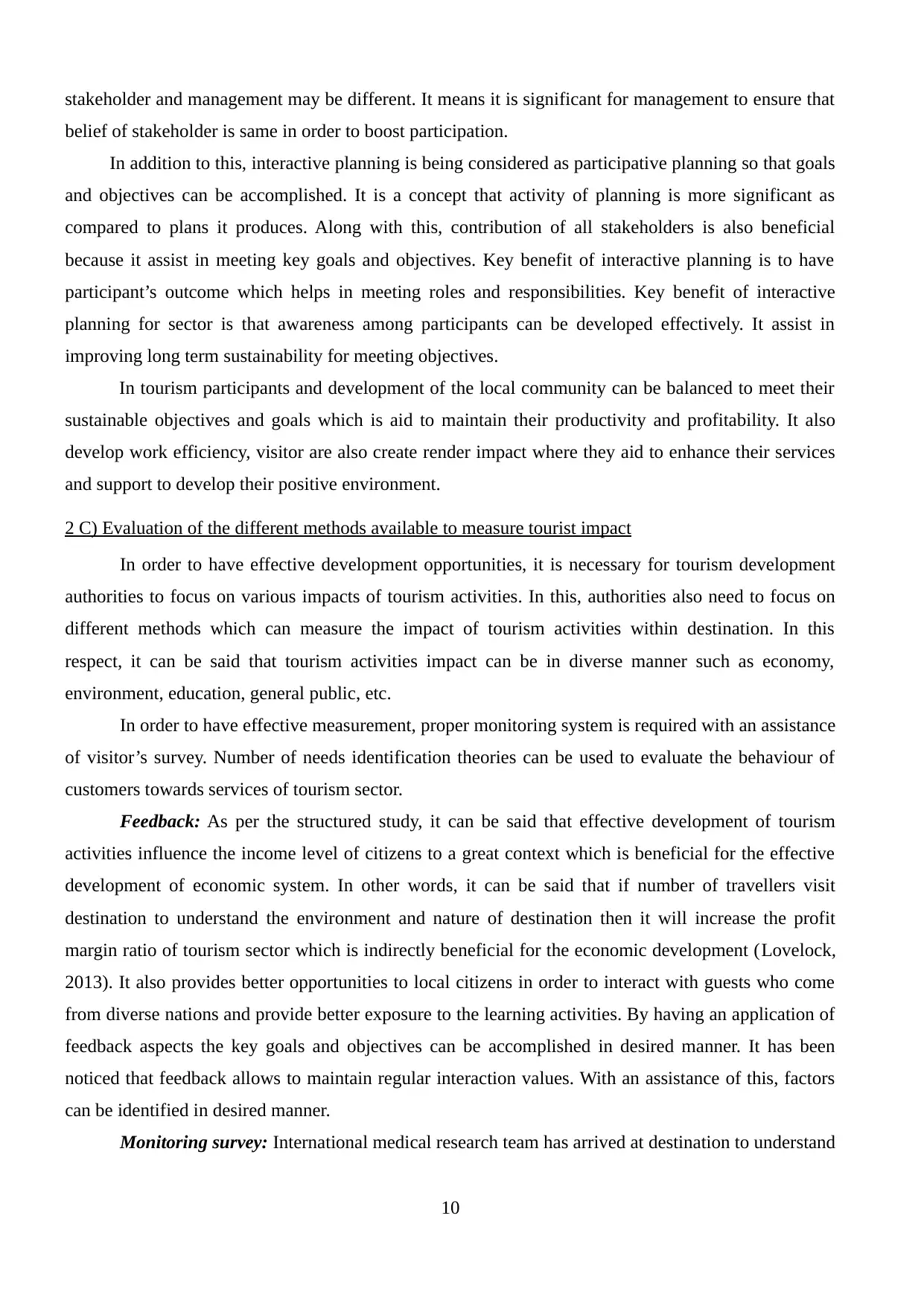
stakeholder and management may be different. It means it is significant for management to ensure that
belief of stakeholder is same in order to boost participation.
In addition to this, interactive planning is being considered as participative planning so that goals
and objectives can be accomplished. It is a concept that activity of planning is more significant as
compared to plans it produces. Along with this, contribution of all stakeholders is also beneficial
because it assist in meeting key goals and objectives. Key benefit of interactive planning is to have
participant’s outcome which helps in meeting roles and responsibilities. Key benefit of interactive
planning for sector is that awareness among participants can be developed effectively. It assist in
improving long term sustainability for meeting objectives.
In tourism participants and development of the local community can be balanced to meet their
sustainable objectives and goals which is aid to maintain their productivity and profitability. It also
develop work efficiency, visitor are also create render impact where they aid to enhance their services
and support to develop their positive environment.
2 C) Evaluation of the different methods available to measure tourist impact
In order to have effective development opportunities, it is necessary for tourism development
authorities to focus on various impacts of tourism activities. In this, authorities also need to focus on
different methods which can measure the impact of tourism activities within destination. In this
respect, it can be said that tourism activities impact can be in diverse manner such as economy,
environment, education, general public, etc.
In order to have effective measurement, proper monitoring system is required with an assistance
of visitor’s survey. Number of needs identification theories can be used to evaluate the behaviour of
customers towards services of tourism sector.
Feedback: As per the structured study, it can be said that effective development of tourism
activities influence the income level of citizens to a great context which is beneficial for the effective
development of economic system. In other words, it can be said that if number of travellers visit
destination to understand the environment and nature of destination then it will increase the profit
margin ratio of tourism sector which is indirectly beneficial for the economic development (Lovelock,
2013). It also provides better opportunities to local citizens in order to interact with guests who come
from diverse nations and provide better exposure to the learning activities. By having an application of
feedback aspects the key goals and objectives can be accomplished in desired manner. It has been
noticed that feedback allows to maintain regular interaction values. With an assistance of this, factors
can be identified in desired manner.
Monitoring survey: International medical research team has arrived at destination to understand
10
belief of stakeholder is same in order to boost participation.
In addition to this, interactive planning is being considered as participative planning so that goals
and objectives can be accomplished. It is a concept that activity of planning is more significant as
compared to plans it produces. Along with this, contribution of all stakeholders is also beneficial
because it assist in meeting key goals and objectives. Key benefit of interactive planning is to have
participant’s outcome which helps in meeting roles and responsibilities. Key benefit of interactive
planning for sector is that awareness among participants can be developed effectively. It assist in
improving long term sustainability for meeting objectives.
In tourism participants and development of the local community can be balanced to meet their
sustainable objectives and goals which is aid to maintain their productivity and profitability. It also
develop work efficiency, visitor are also create render impact where they aid to enhance their services
and support to develop their positive environment.
2 C) Evaluation of the different methods available to measure tourist impact
In order to have effective development opportunities, it is necessary for tourism development
authorities to focus on various impacts of tourism activities. In this, authorities also need to focus on
different methods which can measure the impact of tourism activities within destination. In this
respect, it can be said that tourism activities impact can be in diverse manner such as economy,
environment, education, general public, etc.
In order to have effective measurement, proper monitoring system is required with an assistance
of visitor’s survey. Number of needs identification theories can be used to evaluate the behaviour of
customers towards services of tourism sector.
Feedback: As per the structured study, it can be said that effective development of tourism
activities influence the income level of citizens to a great context which is beneficial for the effective
development of economic system. In other words, it can be said that if number of travellers visit
destination to understand the environment and nature of destination then it will increase the profit
margin ratio of tourism sector which is indirectly beneficial for the economic development (Lovelock,
2013). It also provides better opportunities to local citizens in order to interact with guests who come
from diverse nations and provide better exposure to the learning activities. By having an application of
feedback aspects the key goals and objectives can be accomplished in desired manner. It has been
noticed that feedback allows to maintain regular interaction values. With an assistance of this, factors
can be identified in desired manner.
Monitoring survey: International medical research team has arrived at destination to understand
10
Paraphrase This Document
Need a fresh take? Get an instant paraphrase of this document with our AI Paraphraser
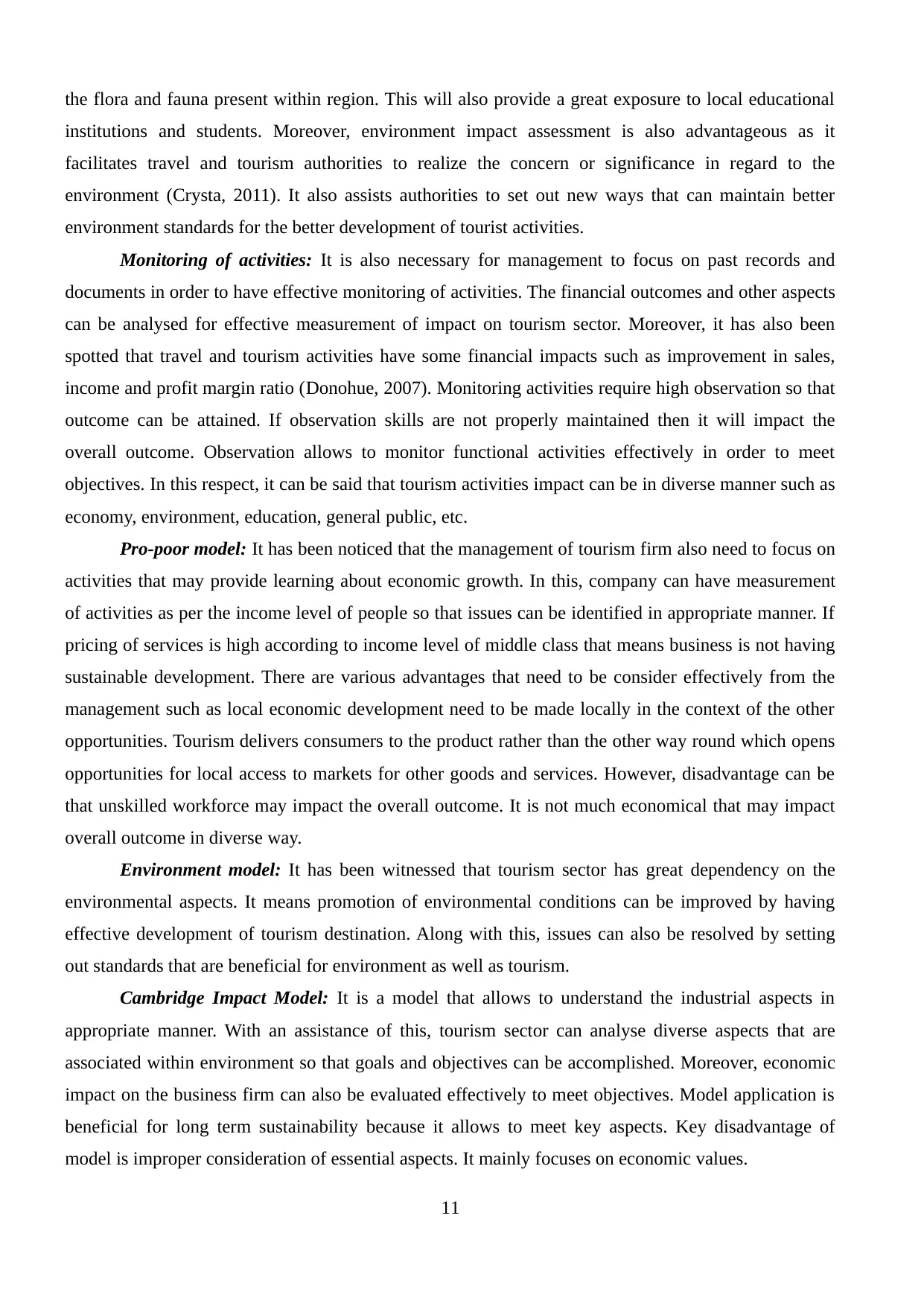
the flora and fauna present within region. This will also provide a great exposure to local educational
institutions and students. Moreover, environment impact assessment is also advantageous as it
facilitates travel and tourism authorities to realize the concern or significance in regard to the
environment (Crysta, 2011). It also assists authorities to set out new ways that can maintain better
environment standards for the better development of tourist activities.
Monitoring of activities: It is also necessary for management to focus on past records and
documents in order to have effective monitoring of activities. The financial outcomes and other aspects
can be analysed for effective measurement of impact on tourism sector. Moreover, it has also been
spotted that travel and tourism activities have some financial impacts such as improvement in sales,
income and profit margin ratio (Donohue, 2007). Monitoring activities require high observation so that
outcome can be attained. If observation skills are not properly maintained then it will impact the
overall outcome. Observation allows to monitor functional activities effectively in order to meet
objectives. In this respect, it can be said that tourism activities impact can be in diverse manner such as
economy, environment, education, general public, etc.
Pro-poor model: It has been noticed that the management of tourism firm also need to focus on
activities that may provide learning about economic growth. In this, company can have measurement
of activities as per the income level of people so that issues can be identified in appropriate manner. If
pricing of services is high according to income level of middle class that means business is not having
sustainable development. There are various advantages that need to be consider effectively from the
management such as local economic development need to be made locally in the context of the other
opportunities. Tourism delivers consumers to the product rather than the other way round which opens
opportunities for local access to markets for other goods and services. However, disadvantage can be
that unskilled workforce may impact the overall outcome. It is not much economical that may impact
overall outcome in diverse way.
Environment model: It has been witnessed that tourism sector has great dependency on the
environmental aspects. It means promotion of environmental conditions can be improved by having
effective development of tourism destination. Along with this, issues can also be resolved by setting
out standards that are beneficial for environment as well as tourism.
Cambridge Impact Model: It is a model that allows to understand the industrial aspects in
appropriate manner. With an assistance of this, tourism sector can analyse diverse aspects that are
associated within environment so that goals and objectives can be accomplished. Moreover, economic
impact on the business firm can also be evaluated effectively to meet objectives. Model application is
beneficial for long term sustainability because it allows to meet key aspects. Key disadvantage of
model is improper consideration of essential aspects. It mainly focuses on economic values.
11
institutions and students. Moreover, environment impact assessment is also advantageous as it
facilitates travel and tourism authorities to realize the concern or significance in regard to the
environment (Crysta, 2011). It also assists authorities to set out new ways that can maintain better
environment standards for the better development of tourist activities.
Monitoring of activities: It is also necessary for management to focus on past records and
documents in order to have effective monitoring of activities. The financial outcomes and other aspects
can be analysed for effective measurement of impact on tourism sector. Moreover, it has also been
spotted that travel and tourism activities have some financial impacts such as improvement in sales,
income and profit margin ratio (Donohue, 2007). Monitoring activities require high observation so that
outcome can be attained. If observation skills are not properly maintained then it will impact the
overall outcome. Observation allows to monitor functional activities effectively in order to meet
objectives. In this respect, it can be said that tourism activities impact can be in diverse manner such as
economy, environment, education, general public, etc.
Pro-poor model: It has been noticed that the management of tourism firm also need to focus on
activities that may provide learning about economic growth. In this, company can have measurement
of activities as per the income level of people so that issues can be identified in appropriate manner. If
pricing of services is high according to income level of middle class that means business is not having
sustainable development. There are various advantages that need to be consider effectively from the
management such as local economic development need to be made locally in the context of the other
opportunities. Tourism delivers consumers to the product rather than the other way round which opens
opportunities for local access to markets for other goods and services. However, disadvantage can be
that unskilled workforce may impact the overall outcome. It is not much economical that may impact
overall outcome in diverse way.
Environment model: It has been witnessed that tourism sector has great dependency on the
environmental aspects. It means promotion of environmental conditions can be improved by having
effective development of tourism destination. Along with this, issues can also be resolved by setting
out standards that are beneficial for environment as well as tourism.
Cambridge Impact Model: It is a model that allows to understand the industrial aspects in
appropriate manner. With an assistance of this, tourism sector can analyse diverse aspects that are
associated within environment so that goals and objectives can be accomplished. Moreover, economic
impact on the business firm can also be evaluated effectively to meet objectives. Model application is
beneficial for long term sustainability because it allows to meet key aspects. Key disadvantage of
model is improper consideration of essential aspects. It mainly focuses on economic values.
11
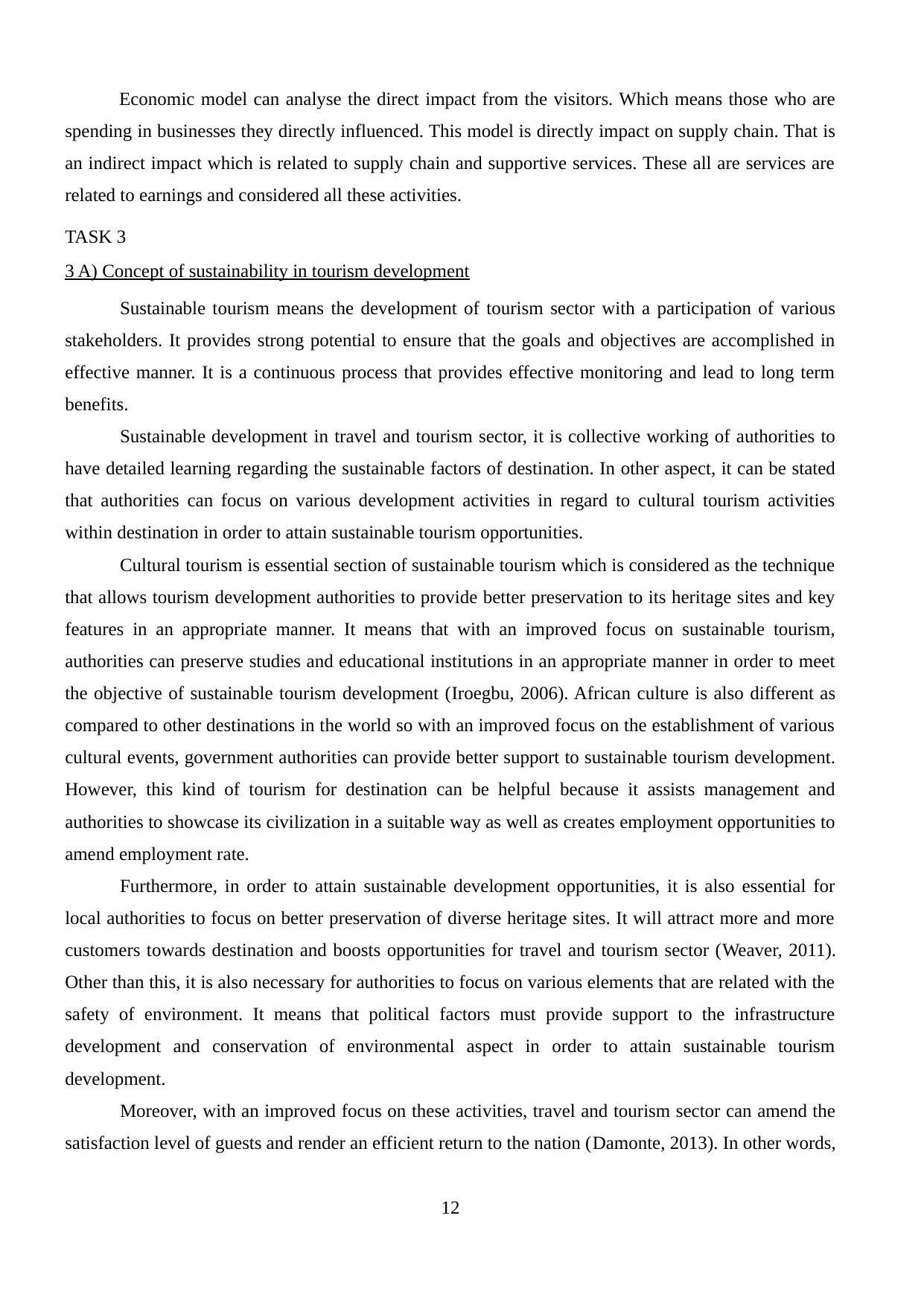
Economic model can analyse the direct impact from the visitors. Which means those who are
spending in businesses they directly influenced. This model is directly impact on supply chain. That is
an indirect impact which is related to supply chain and supportive services. These all are services are
related to earnings and considered all these activities.
TASK 3
3 A) Concept of sustainability in tourism development
Sustainable tourism means the development of tourism sector with a participation of various
stakeholders. It provides strong potential to ensure that the goals and objectives are accomplished in
effective manner. It is a continuous process that provides effective monitoring and lead to long term
benefits.
Sustainable development in travel and tourism sector, it is collective working of authorities to
have detailed learning regarding the sustainable factors of destination. In other aspect, it can be stated
that authorities can focus on various development activities in regard to cultural tourism activities
within destination in order to attain sustainable tourism opportunities.
Cultural tourism is essential section of sustainable tourism which is considered as the technique
that allows tourism development authorities to provide better preservation to its heritage sites and key
features in an appropriate manner. It means that with an improved focus on sustainable tourism,
authorities can preserve studies and educational institutions in an appropriate manner in order to meet
the objective of sustainable tourism development (Iroegbu, 2006). African culture is also different as
compared to other destinations in the world so with an improved focus on the establishment of various
cultural events, government authorities can provide better support to sustainable tourism development.
However, this kind of tourism for destination can be helpful because it assists management and
authorities to showcase its civilization in a suitable way as well as creates employment opportunities to
amend employment rate.
Furthermore, in order to attain sustainable development opportunities, it is also essential for
local authorities to focus on better preservation of diverse heritage sites. It will attract more and more
customers towards destination and boosts opportunities for travel and tourism sector (Weaver, 2011).
Other than this, it is also necessary for authorities to focus on various elements that are related with the
safety of environment. It means that political factors must provide support to the infrastructure
development and conservation of environmental aspect in order to attain sustainable tourism
development.
Moreover, with an improved focus on these activities, travel and tourism sector can amend the
satisfaction level of guests and render an efficient return to the nation (Damonte, 2013). In other words,
12
spending in businesses they directly influenced. This model is directly impact on supply chain. That is
an indirect impact which is related to supply chain and supportive services. These all are services are
related to earnings and considered all these activities.
TASK 3
3 A) Concept of sustainability in tourism development
Sustainable tourism means the development of tourism sector with a participation of various
stakeholders. It provides strong potential to ensure that the goals and objectives are accomplished in
effective manner. It is a continuous process that provides effective monitoring and lead to long term
benefits.
Sustainable development in travel and tourism sector, it is collective working of authorities to
have detailed learning regarding the sustainable factors of destination. In other aspect, it can be stated
that authorities can focus on various development activities in regard to cultural tourism activities
within destination in order to attain sustainable tourism opportunities.
Cultural tourism is essential section of sustainable tourism which is considered as the technique
that allows tourism development authorities to provide better preservation to its heritage sites and key
features in an appropriate manner. It means that with an improved focus on sustainable tourism,
authorities can preserve studies and educational institutions in an appropriate manner in order to meet
the objective of sustainable tourism development (Iroegbu, 2006). African culture is also different as
compared to other destinations in the world so with an improved focus on the establishment of various
cultural events, government authorities can provide better support to sustainable tourism development.
However, this kind of tourism for destination can be helpful because it assists management and
authorities to showcase its civilization in a suitable way as well as creates employment opportunities to
amend employment rate.
Furthermore, in order to attain sustainable development opportunities, it is also essential for
local authorities to focus on better preservation of diverse heritage sites. It will attract more and more
customers towards destination and boosts opportunities for travel and tourism sector (Weaver, 2011).
Other than this, it is also necessary for authorities to focus on various elements that are related with the
safety of environment. It means that political factors must provide support to the infrastructure
development and conservation of environmental aspect in order to attain sustainable tourism
development.
Moreover, with an improved focus on these activities, travel and tourism sector can amend the
satisfaction level of guests and render an efficient return to the nation (Damonte, 2013). In other words,
12
⊘ This is a preview!⊘
Do you want full access?
Subscribe today to unlock all pages.

Trusted by 1+ million students worldwide
1 out of 24
Related Documents
Your All-in-One AI-Powered Toolkit for Academic Success.
+13062052269
info@desklib.com
Available 24*7 on WhatsApp / Email
![[object Object]](/_next/static/media/star-bottom.7253800d.svg)
Unlock your academic potential
Copyright © 2020–2025 A2Z Services. All Rights Reserved. Developed and managed by ZUCOL.



